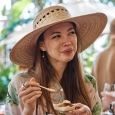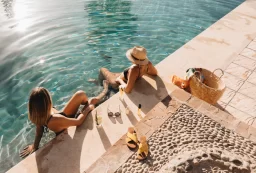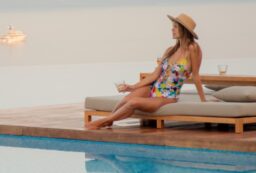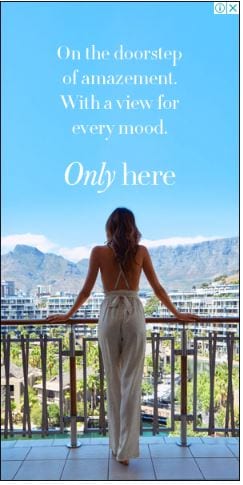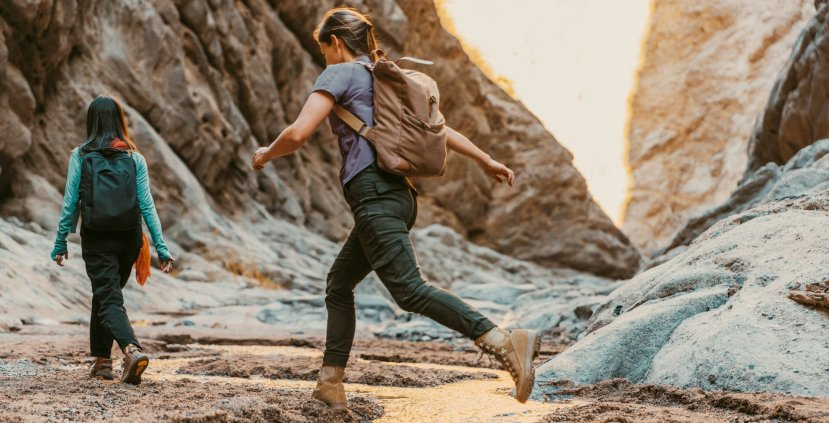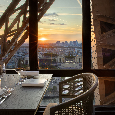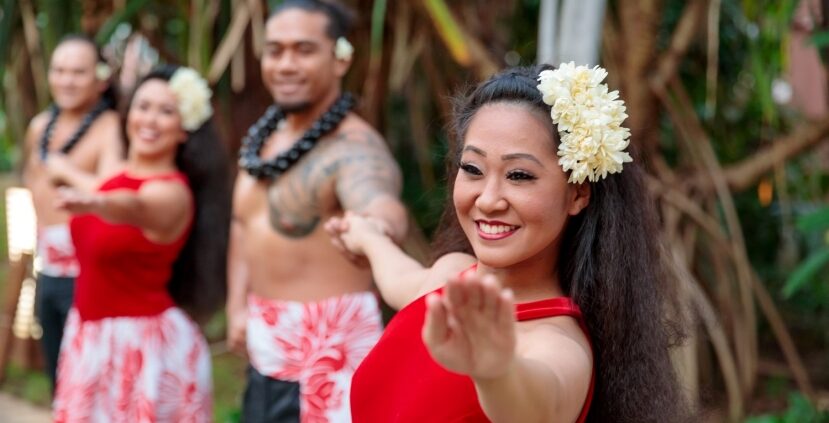
Hawaii is an eternally popular destination, and yet capital city Honolulu had been regarded as more of a gateway to paradise than the main destination. As sprawling Waikiki resorts, large international hospitality chains, and the city’s urban expanse appeared to contradict what Hawaii represented in the public consciousness, it was not surprising that some travelers were drawn to the other islands with their quieter settings, expansive golf courses, romantic beachfront restaurants, and secluded spas. However, Honolulu is primed for rediscovery, thanks to independently-owned hotels such as Halepuna Waikiki by Halekulani, recently retrofitted for 21st century guests without compromising the ways the aloha spirit has expressed itself within the Honolulu lifestyle.

Halepuna’s 2021 reopening coincided with an emergence of a new generation of travelers actively seeking “city break” vacations where they could explore emerging neighborhoods and enclaves, a well-rounded food scene (from white tablecloth experiences to innovative cocktail bars and food truck parks), world class museums, and cultural sites in unexpected places.

Halepuna is walking distance to Waikiki Beach and Royal Hawaiian Center (noted for its unique-to-Hawaii boutiques as well as outposts of Fendi, Hermes, Harry Winston, and others), it also offers easy access to natural and historic wonders with a variety of guest perks prompting visitors to get off the beach from time to time.

All guests get free admission to the Honolulu Museum of Art and the Bishop Museum by showing their room key at the ticket desk of the museums. While the former is dedicated to Hawaii’s natural history, and the latter displays paintings and sculptures from noted artists around the world, both building are also historically significant.
" Hawaii is still synonymous with “paradise,” thanks to its beaches, flora, fauna, year-long summer climate, and laid back culture. What’s there not to love about sun, fun, a compelling history, colorful clothing, the surf scene, and perfect weather?"
The Bishop Museum was built in 1889 by Charles Bishop for wife Princess Bernice Pauahi Bishop, a member of Hawaii’s royal family, while the Honolulu Museum of Art dates to 1927 and integrates Hawaiian, Chinese, and Spanish architectural elements that have since been adopted for a variety of buildings across the state.
 The most breathtaking excursion offered by the Halepuna and Halekulani, a day at the Mānoa Heritage Center, provides a blissful break from one’s “city break.” Halepuna can book guests for an intimate tour through the lush 3.5 acre setting, which contains Kūkaʻōʻō Heiau, the last intact ancient temple (heiau) in Waikiki proper, as well as a vibrant and diverse collection of native Hawaiian plants and garden of Polynesian-introduced plants.
The most breathtaking excursion offered by the Halepuna and Halekulani, a day at the Mānoa Heritage Center, provides a blissful break from one’s “city break.” Halepuna can book guests for an intimate tour through the lush 3.5 acre setting, which contains Kūkaʻōʻō Heiau, the last intact ancient temple (heiau) in Waikiki proper, as well as a vibrant and diverse collection of native Hawaiian plants and garden of Polynesian-introduced plants.
 The 284-room Halepuna itself endeavors to be a streamlined version of a lush tropical paradise, presenting as an antidote to the bustling and sometimes-kitschy settings of other resorts and shopping areas. The statement décor at Halepuna is reserved for restaurants on the property and others managed by its parent company such as the also-renovated “House Without A Key” in older sister property Halekulani. The lobby is fashioned with an almost minimalist aesthetic, save for some streamlined but pretty flower arrangements and intentionally curated pieces from Halepuna Waikiki’s public art program showcasing artists whose works reflect a personal sense of place. Halepuna’s eighth floor setup, incorporating the Vitality Pool and Sun Deck, The Gardens relaxation area, Hospitality Suite (the hotel’s answer to a business center), and fitness studio, is nicely suited for acclimating after a long flight from the mainland.
The 284-room Halepuna itself endeavors to be a streamlined version of a lush tropical paradise, presenting as an antidote to the bustling and sometimes-kitschy settings of other resorts and shopping areas. The statement décor at Halepuna is reserved for restaurants on the property and others managed by its parent company such as the also-renovated “House Without A Key” in older sister property Halekulani. The lobby is fashioned with an almost minimalist aesthetic, save for some streamlined but pretty flower arrangements and intentionally curated pieces from Halepuna Waikiki’s public art program showcasing artists whose works reflect a personal sense of place. Halepuna’s eighth floor setup, incorporating the Vitality Pool and Sun Deck, The Gardens relaxation area, Hospitality Suite (the hotel’s answer to a business center), and fitness studio, is nicely suited for acclimating after a long flight from the mainland.
 There’s a similar appeal to the individual suites, with a pleasing blend of crisp whites, warm woods, blue ombre accent walls, and flooring that visually represents the sky or the ocean, depending on your perspective. The headlining feature, however, is floor-to-ceiling windows that deliver the first hit of ocean breezes and “wow” factor of beach and Pacific Ocean views even before one sets his or her luggage down. The bathroom is elegant in a similarly understated way. The glass-enclosed shower and deep-soaking bathtub is further enhanced when using the hotel’s SpaHalekulani line of fragrant bath amenities made with Hawaiian oils and extracts. While Halepuna’s spa was still in transition at press time, personalized in-room massages and facials, lomi lomi massages, private yoga sessions, and other services will be coordinated by Kamala Nayeli, Spa and Wellness Director for Halekulani and Halepuna, to ensure consistency and quality.
There’s a similar appeal to the individual suites, with a pleasing blend of crisp whites, warm woods, blue ombre accent walls, and flooring that visually represents the sky or the ocean, depending on your perspective. The headlining feature, however, is floor-to-ceiling windows that deliver the first hit of ocean breezes and “wow” factor of beach and Pacific Ocean views even before one sets his or her luggage down. The bathroom is elegant in a similarly understated way. The glass-enclosed shower and deep-soaking bathtub is further enhanced when using the hotel’s SpaHalekulani line of fragrant bath amenities made with Hawaiian oils and extracts. While Halepuna’s spa was still in transition at press time, personalized in-room massages and facials, lomi lomi massages, private yoga sessions, and other services will be coordinated by Kamala Nayeli, Spa and Wellness Director for Halekulani and Halepuna, to ensure consistency and quality.
 UMI by Vikram Garg, the property’s just-opened fine dining establishment, goes beyond satisfying a pan-Asian craving (especially if your schedule doesn’t allow for a jaunt to Chinatown). Garg and his team elevate Hawaiian-grown ingredients—particularly fish and seafood—through bold flavor combinations. Guests can create their own global adventure with his a la carte menu, or delve into his more ambitious recipes through his “Waikiki,” “UMI,” or “Curry Dinner” tasting menus. His splurge-worthy breakfasts have quickly made the restaurant a popular “special occasion” spot among discerning Honolulu residents.
UMI by Vikram Garg, the property’s just-opened fine dining establishment, goes beyond satisfying a pan-Asian craving (especially if your schedule doesn’t allow for a jaunt to Chinatown). Garg and his team elevate Hawaiian-grown ingredients—particularly fish and seafood—through bold flavor combinations. Guests can create their own global adventure with his a la carte menu, or delve into his more ambitious recipes through his “Waikiki,” “UMI,” or “Curry Dinner” tasting menus. His splurge-worthy breakfasts have quickly made the restaurant a popular “special occasion” spot among discerning Honolulu residents.
 Christian Testa, Executive Chef for both the Halepuna and Halekulani, has worked his magic at House Without A Key (located right on the beach flanking the Halekulani), which remains one of the Waikiki’s most foundational restaurants through its recent re-opening. In collaboration with Chef Jarrin Otake, the menu is awash with timely updates on familiar favorites from the islands and the mainland.
Christian Testa, Executive Chef for both the Halepuna and Halekulani, has worked his magic at House Without A Key (located right on the beach flanking the Halekulani), which remains one of the Waikiki’s most foundational restaurants through its recent re-opening. In collaboration with Chef Jarrin Otake, the menu is awash with timely updates on familiar favorites from the islands and the mainland.
"Honolulu is primed for rediscovery, thanks to independently-owned hotels such as Halepuna Waikiki by Halekulani "
Best-sellers include a reinvention of the traditional “laulau” plate with pork and butterfish arranged on a bed of coconut-stewed luau leaves; Char Siu Coconut Baby Back Ribs; and a “Skizza” flatbread that gives an island twist to the Margherita pizza. The Yellow Umbrella, one of the newer cocktails, is tailored for more cosmopolitan palates with Lilikoi Juice, Coconut Matcha Syrup, Tequila and Mezcal.
Beyond the Beach

At the Royal Hawaiian Center, minutes from Halepuna’s Kalakaua Avenue side entrance, Island Vintage Wine Bar (a favorite of former president Barak Obama) streamlined menu of home-grown and globally-influenced Hawaiian appetizers, share plates, poke, and sandwiches. About 40 selections curated by wine director Mark Cartland (a veteran of Los Angeles’ and San Diego’s restaurant scenes) are available, served in cuvenee dispensers perfect for sampling, or by the glass, bottle, or flights. Local craft beer, hard cider, sake, and a full bar completes this bonafide local favorite. The center is also home to an outpost of the New York City-born Wolfgang’s Steakhouse, with undeniably Hawaiian riffs on its classic formula and a branch of TsuruTonTan, originating from Japan’s Kanto and Kansai prefectures and known for its refined take on udon dishes and soups.

Avid urban explorers will appreciate that city’s buzziest neighborhoods are just a short bus ride or Uber away. Nuuanu Avenue, running through Oahu’s Chinatown, has evolved over the past two decades into one of the city’s definitive cocktail bar and nightlife hubs. The area has been further refined and spiced up with art galleries, quirky shops, and contemporary dining options which can be enjoyed by day. Nearby North Beretania Street is perhaps the most pan-Asian of Chinatowns in the U.S., as many of its business owners are Japanese, Malaysian, Korean, Filipino, and Vietnamese ancestry. Although the 15-block area had been rebuilt a few times due to fires and other calamities, their impact on Oahu’s cultural scene can be felt through the neighborhood’s Buddhist shrines.
 Other arty high-concept retail/dining areas include the SALT Complex, made up of industrial buildings repurposed into coffee bars, surf shops, restaurants, a record store, nightlife venues, and a space where fleas showcasing local artists and designers are periodically staged. South Shore Market is another place to find goods and specialty treats that are proudly Oahu- and Hawaii-made. To escape from shopping and see what living local is truly like, do a jog or bike ride along Ala Wai Boulevard, named for a man-made canal that runs parallel to it a half-mile north of Waikiki Beach. Along with nicely-paved paths, you get great views the ocean and the mountains, minus beach crowds and heavy traffic.
Other arty high-concept retail/dining areas include the SALT Complex, made up of industrial buildings repurposed into coffee bars, surf shops, restaurants, a record store, nightlife venues, and a space where fleas showcasing local artists and designers are periodically staged. South Shore Market is another place to find goods and specialty treats that are proudly Oahu- and Hawaii-made. To escape from shopping and see what living local is truly like, do a jog or bike ride along Ala Wai Boulevard, named for a man-made canal that runs parallel to it a half-mile north of Waikiki Beach. Along with nicely-paved paths, you get great views the ocean and the mountains, minus beach crowds and heavy traffic.

Hawaii is still synonymous with “paradise,” thanks to its beaches, flora, fauna, year-long summer climate, and laid back culture. What’s there not to love about sun, fun, a compelling history, colorful clothing, the surf scene, and perfect weather? Although Halepuna by Halekulani is the newest addition to Waikiki Beach’s urban paradise, it builds upon the legend established by Halekulani during the 20th century even as it reveals that what defines sophistication in Honolulu and Waikiki has come a long way.
